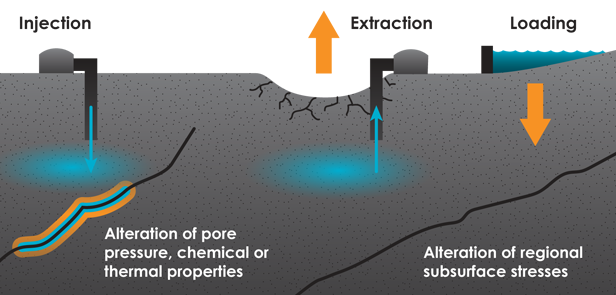Seismic stimulation ContentsIntroductionThe idea that stimulating earthquakes might be good runs into the widespread intunition that earthquakes are bad and should be avoided.However, induced seismicity could be beneficial if the induced earthquakes are small and they have the effect of sapping energy from larger quakes. It has long been observed that earthquakes reduce the liklihood of further earthquakes in the short term. Also, large quakes are much more destructive than small quakes. If we could trade some large quakes for many smaller ones that could be a good deal.
Benefits are a real possibilityScientists consider the possibilty that that deliberate seismic stimulation might be beneficial seriously:
induced seismicity can cause short-term increases in the seismic hazard that are followed by a period of reduced seismic hazard. [...] - Induced Seismicity Reduces Seismic Hazard? Another paper states: Injection in areas with moderate tectonic strain may temporarily increase the local seismic hazard, but widespread IIE over an extended period of time may deplete the available tectonic moment and could, under the right conditions, have a limited long term effect of reducing regional seismic hazard.
Earthquake amplificationAn interesting possibility is earthquake amplification. That attempts to prolong existing earthquakes. This works on the principle of inertia: it is easier to continue an existing quake than it is to start a new one. You have to be in the right place at the right time to make this work, but that should be possiible.
Other similar systemsSimilarly, puncturing volcanos might lead to reduced damage from major eruptions, stimulating rainfall could result in less storm damage and stimulating landslides could lead to less damage from major landslides.The case of "landslides" is interesting partly because it is very easy to build models of landslides. There's a theory involving "self-organized criticality" that predicts the distribution of landslide size. Stimulating landslides is unlikely to lead to more severe landslides in these models - since the rate of influx of material is constant. However, whether landslide severity decreases or the frequency of major landslides goes down would be interesting to investigate experimentally. It seems highly likely that this would be the case, but details and experimental results might help to make the case.
Damage extentLarge earthquakes - and the tsunamis they trigger - cause considerable damage. That makes it worth exploring the issue of whether they can be attenuated.
Research neededWhile it seems plausible that inducing earthquakes would lead to reduced damage from large earthquakes over time, details are currently obscure. How much would it cost? What would be the scale of the benefits? What would be the best way to induce earthquakes? When should the technique be applied?
Legal issuesExperience suggests that those inducing earthquakes could face lawsuits. This mae be true even if there is good evidence that this reduces long-term average harm. Killing one person to save two is still often categorized as "murder" - and is punishable accordingly. Seismic stimulation may be best performed by governments, and other large agents able to make a convincing utilitarian case for their actions.
Historical usageSeismic stimulation has been used in the past to release fossil fuel deposits. See references below for details.Seismic stimulation is also a well-known and widespread side effect of fracking, building dams and building skyscrapers.
References
|